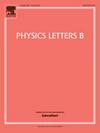Electromagnetic |GE/GM| ratios of hyperons at large timelike q2
IF 4.3
2区 物理与天体物理
Q1 ASTRONOMY & ASTROPHYSICS
引用次数: 0
Abstract
In recent years, it has become possible to measure not only the magnitude of the electric () and magnetic () form factors of spin baryons, but also to measure the relative phases of those quantities in the timelike kinematic region. Aiming to interpret present data on hyperons of the baryon octet, as well as to predict future data, we present model calculations of that ratio for large invariant 4-momentum square in the timelike region (). Without any further parameter fitting, we extend to the timelike region a covariant quark model previously developed to describe the kinematic spacelike region () of the baryon octet form factors. The model takes into account both the effects of valence quarks and the excitations of the meson cloud which dresses the baryons. This application to the timelike region assumes an approximation based on unitarity and analyticity that is valid only in the large region. Using the recent data from BESIII we establish the regime of validity of this approximation. We report here that our results for the effective form factor (combination of and ) are in good agreement with the data already for values above 15 GeV2. In addition, a more conservative onset of the validity of the approximation is provided by the newly available data which suggest that our predictions may be compared against data for 20 GeV2. This is expected in the near future, when the range of the present measurements is expanded to the 20–50 GeV2 region.
大时空q2下超子的电磁|GE/GM|比率
近年来,我们不仅可以测量自旋 12 重子的电(GE)和磁(GM)形式因子的大小,还可以测量这些量在时间运动学区域的相对相位。为了解释目前关于重子八元组超子的|GE/GM|数据,并预测未来的数据,我们提出了在类时间区(q2>0)中大不变四动量平方q2的该比值的模型计算。在不做任何进一步参数拟合的情况下,我们将先前为描述重子八元形式因子的运动空间区域(q2≤0)而建立的一个协变夸克模型扩展到了类时间区域。该模型既考虑了价夸克的影响,也考虑了介子云的激发,介子云是重子的外衣。该模型应用于类时间区域时,假定了一种基于单位性和解析性的近似,而这种近似只在大 q2 区域有效。利用 BESIII 的最新数据,我们确定了这一近似的有效范围。我们在这里报告说,我们对有效形式因子(|GE|和|GM|的组合)的计算结果与q2值超过15 GeV2时的数据非常吻合。此外,新获得的|GE/GM|数据为近似的有效性提供了一个更为保守的起点,表明我们的预测可以与q2≥20 GeV2的数据进行比较。预计在不久的将来,当目前的测量范围扩大到 20-50 GeV2 区域时,就会出现这种情况。
本文章由计算机程序翻译,如有差异,请以英文原文为准。
求助全文
约1分钟内获得全文
求助全文
来源期刊

Physics Letters B
物理-物理:综合
CiteScore
9.10
自引率
6.80%
发文量
647
审稿时长
3 months
期刊介绍:
Physics Letters B ensures the rapid publication of important new results in particle physics, nuclear physics and cosmology. Specialized editors are responsible for contributions in experimental nuclear physics, theoretical nuclear physics, experimental high-energy physics, theoretical high-energy physics, and astrophysics.
 求助内容:
求助内容: 应助结果提醒方式:
应助结果提醒方式:


